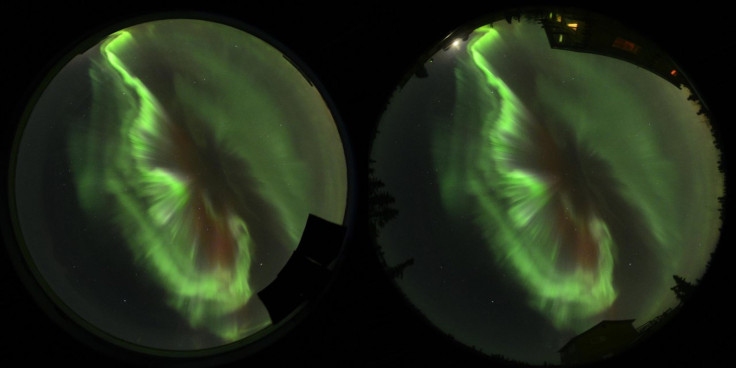Northern Lights Captured In 3D With 2-Camera Setup [PHOTO]

Japanese researchers have come up with a new way to take the measure of the Northern Lights -- and all it requires is two cameras.
The Northern Lights, also known as aurora borealis or the polar aurorae, flare up when energetic particles collide with each other high in the atmosphere. Atmospheric particles are excited by streams of other charged particles released from the sun (solar wind), and emit photons. The different colors of the northern lights stem from the different kinds of particles involved: Oxygen yields a yellow-green, while nitrogen emits blue or purple light. Sometimes, an all-red aurora can result from oxygen molecules colliding very high up in the atmosphere, about 200 miles above the ground. Aurora light can extend anywhere from about 50 miles above the Earth’s surface to 400 miles up.
Ryuho Kataoka, a scientist at the National Institute of Polar research in Japan, came up with a new method of studying aurora borealis while working on a 3D movie for a planetarium. Kataoka and colleagues outlined their technique in a paper published in the journal Annales Geophysicae on Friday. The setup is relatively simple: two cameras, placed 8 kilometers (about 5 miles) apart, on a north-south line. The researchers used two Nikon D4 cameras, each equipped with with an 8 millimeter, F2.8 circular fish-eye lens, to capture the aurora image.
The two-camera set up creates parallax -- the aurora’s apparent movement will look different to each camera. Kataoka and colleagues took those different views and combined the two 2D images to form a 3D picture, similar to how your eyes work in concert to deliver a sense of depth.
"Using the parallax of the left-eye and the right-eye images, we can calculate the distance to the aurora using a [triangulation] method that is similar to the way the human brain comprehends the distance to an object," Kataoka explained in a statement.
When projected onto a planetarium wall, the image from the two cameras can show the aurora in 3D; with the right calculations, it can also be used to calculate the height of the aurora. There are other methods of capturing the height of auroras, but this is the first such one to use commercial components, the authors claim.
“Because of its portability and low cost of the DSLR camera systems, the new technique may open a unique opportunity not only for scientists but also for nightsky photographers” to contribute to aurora borealis science and observations, Kataoka and colleagues wrote.
Your chances of seeing an aurora are severely limited if you live farther away from the poles – although there have been Northern Lights observed as far south as New Orleans, and a recent show lit up the sky in New York City. But thankfully, some scientists have built an aurora borealis in a bottle, for easy viewing! The Planeterella, soon to be on display at the Virginia Air and Space Center, creates a glowing aura around a miniature sphere using its own supply of a magnetic field and charged particles. The device can also mimic the auroras that might be seen on other planets.
“For example, we can show the reaction when Io, the satellite of Jupiter, sends particles to Jupiter. We can also simulate the aurora at Neptune and Uranus, when their magnetic fields are directly pointing towards the sun,” Planeterella creator and NASA scientist Guillaume Gronoff said in an August statement.
SOURCE: Kataoka et al. “Stereoscopic determination of all-sky altitude map of aurora using two ground-based Nikon DSLR cameras.” Annales Geophysicae 31, 1543-1548.
© Copyright IBTimes 2024. All rights reserved.





















